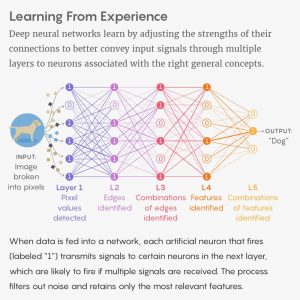Networks in AI Deep Neural Networks
In similar manner to a brain, artificial deep neural networks emulate manners in how signals and information are analyzed and combined together. in both cases, when information is received, the information is compared to previous knowledge and concepts and patterns are found. These patterns and connections create a graph just like we discussed in the beginning of the semester. This is a continuation to the blog post I created n the beginning of the semester on the patterns and connections within a brain. Scientists and searchers are concurrently trying to figure out algorithms and ways to create Artificial intelligence to analyze pictures and content.
As described in the article attached, deep learning in artificial intelligence consist of strengthening or weakening certain connections based on signals and knowledge previously provided. For instance, “ the pixels of a photo of a dog, for instance—up through the layers to neurons associated with the right high-level concepts, such as “dog.” After a deep neural network has “learned” from thousands of sample dog photos, it can identify dogs in new photos as accurately as people can.” Similar to how humans learn more based on experience, programmers are currently creating algorithms to emulate how humans establish connections to artificial intelligence. These programmers realized it is important to start with small networks and make sure their algorithm works before continuing to create mass networks with over 300 facts, pictures and content. This is an important and relevant example of Network Theory in artifical intelligence because scientists are directly creating and analyzing patterns in a network based on labelling connections with 1 or 0 which means it is a strong or weak edge. The strong edges combined can lead to an answer and proper interpretation of content provided to the artificial user. The article also describes a theory known as Bottleneck theory which describes how content is provided and then analyzed by decreasing and limiting content that is not necessary or relevant based on the weak edges as well.
https://www.wired.com/story/new-theory-deep-learning/

